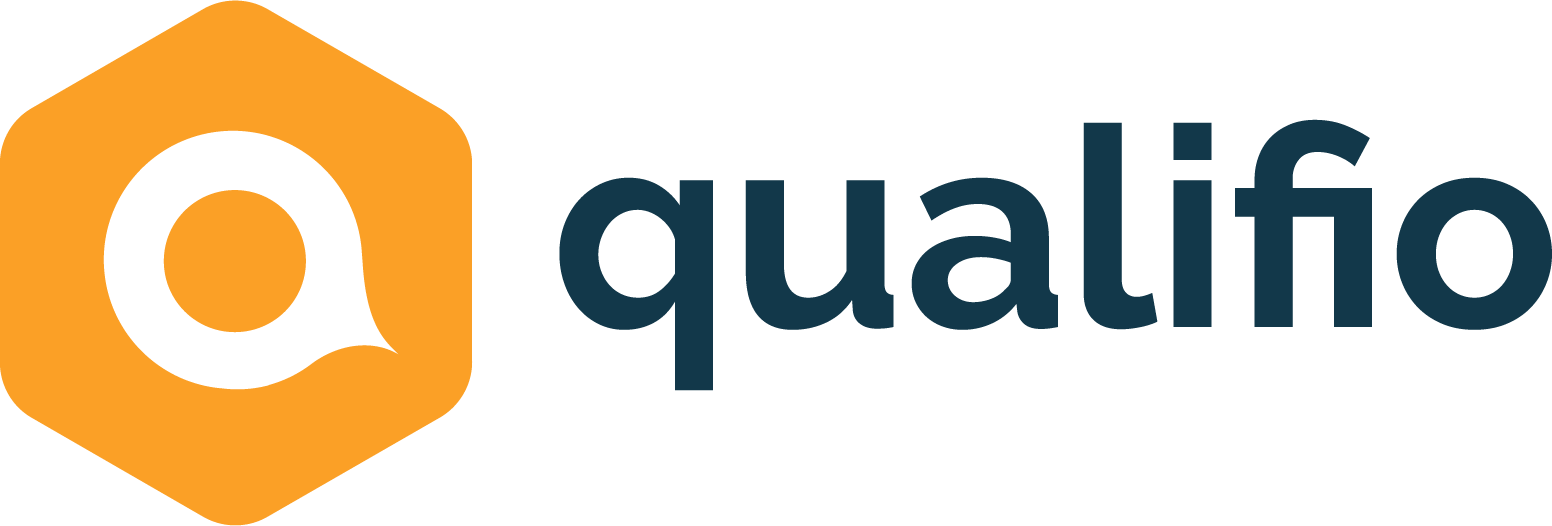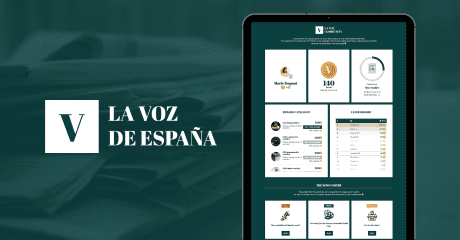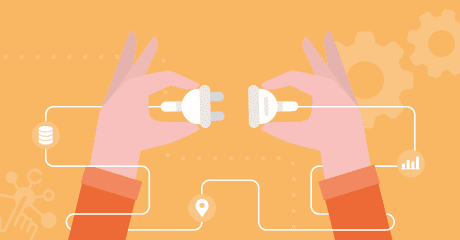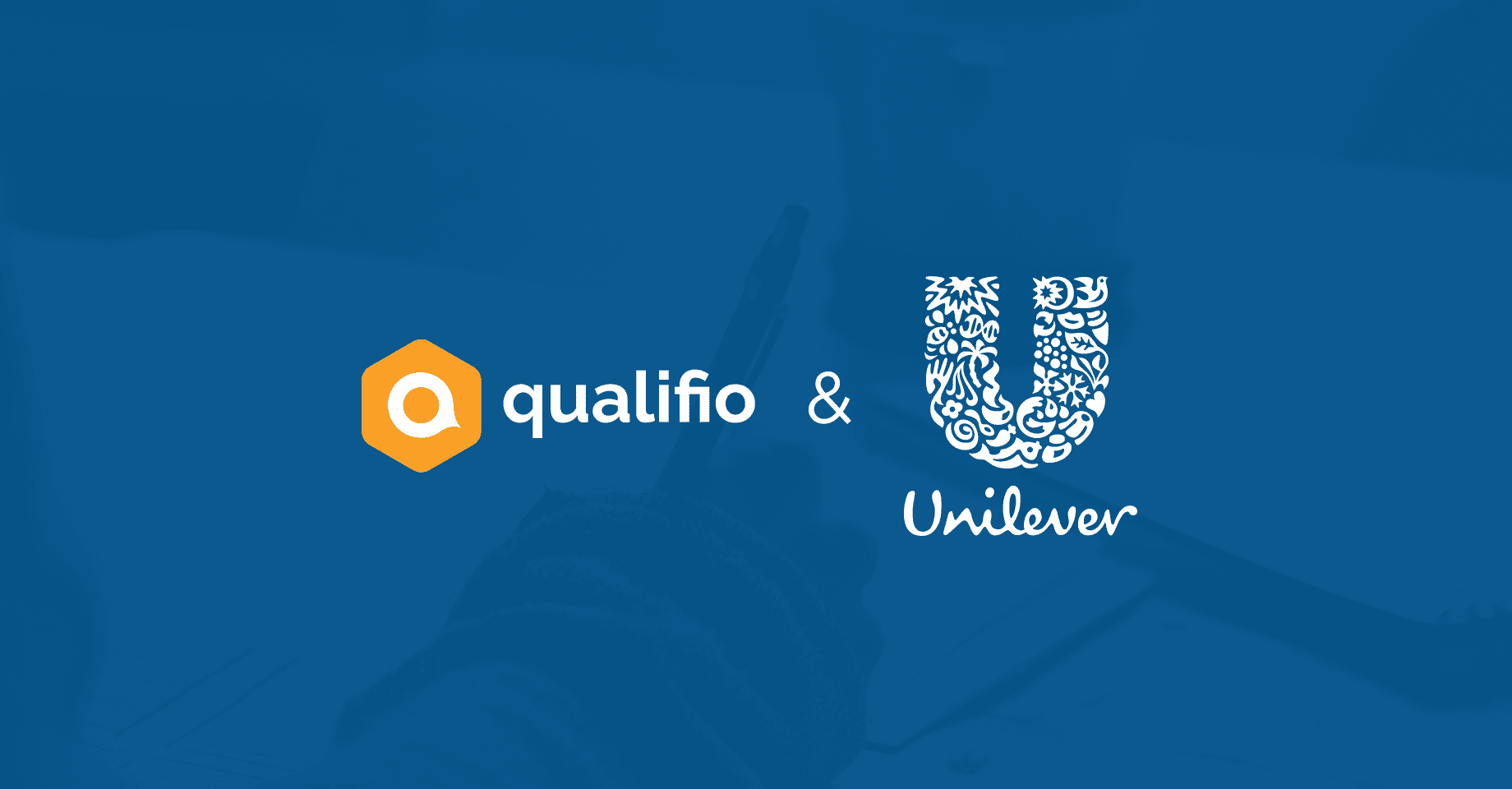Gamification: why is it so useful in marketing?
Gamification is a term that has been used in marketing since the 2010s. It’s one of those buzzwords that gets bandied around a lot, but do you actually know what it means and how it applies in marketing?
The concept of gamification has developed considerably in recent years, particularly in sectors where it wasn’t particularly expected, such as education, health, security, etc.
In this article we’re going to focus on how gamification principles are applied in marketing. Why? Because nowadays, consumer brands are increasingly adopting new and innovative methods to stand out from the competition and to collect first-party and zero-party data from their audience. And out of all of these methods, gamification is certainly the most fun way to do it! 🤩
What is gamification?
Hubspot defines gamification in marketing as:
“the process of turning any process into a game”.
Gamification is still a relatively young concept and is based on interactions around the human-machine relationship where user interfaces are stylised to make them more hedonic, engaging and motivating. Gamification is inspired by game elements but used for non-game purposes, so it’s the transfer of game mechanics into other areas, marketing in our case.
Definition
Researchers have yet to agree on one definitive definition for gamification. Nevertheless, the one by S. Deterding stands out:
“The use of game elements and game design techniques in a non-game context”.
Let’s take a closer look at each of the elements in that definition:
🎮 Game elements are items from the game that players can interact with, such as avatars, levels, ranks etc.
🖌️ Game design techniques define how these game elements work and interact together, within the rules and structure of the game, with the goal of motivating players.
🏞️ Non-game context refers to the business context in which the gamification method is being applied.
Why use gamification?
In their definition, Petkov states that “gamification attempts to influence user behaviour through game design elements“. Meaning that the technique focuses on the emotional, motivational and persuasive elements of an interaction.
Gamification aims to increase user engagement and motivation. So what can brands expect when using this technique?
“Both games and gamification can lead to high levels of learner engagement and motivation.”
If applied efficiently and well, gamification can lead consumers to perform tasks they wouldn’t have done in the first place. But for that to happen, the brand’s products and services need to be shown as enjoyable. How? Showing products in a gamified and visual way has been proven to produce better overall consumer satisfaction and engagement.
The four rules for being a game
An important distinction needs to be made between game and play. In the case of gamification, it is clearly the term ‘game’ that is being used and entails that determined goals are involved.
For a game to be a game, these four rules need to be followed:
1️⃣ A game must have predefined end goals for the players.
2️⃣ A game has to have a set of boundaries that will determine how players act during the game and that takes any limitations and rules into consideration.
3️⃣ During a game, players should adopt a lusory attitude, meaning that they accept a game’s arbitrary rules in order to facilitate the resulting experience.
4️⃣ All players must be playing the game voluntarily.
Specific end goals
A gamified experience can only be called gamification if specific end goals 🎯 have been established and clearly stated.
So, with a predefined end goal, gamification has a meaning and a purpose for consumers, and this will motivate them. Without a solid framework behind all the actions, they have no reason to continue or return to the game.
Pägen’s Repeat it! campaign is an excellent example! Why?
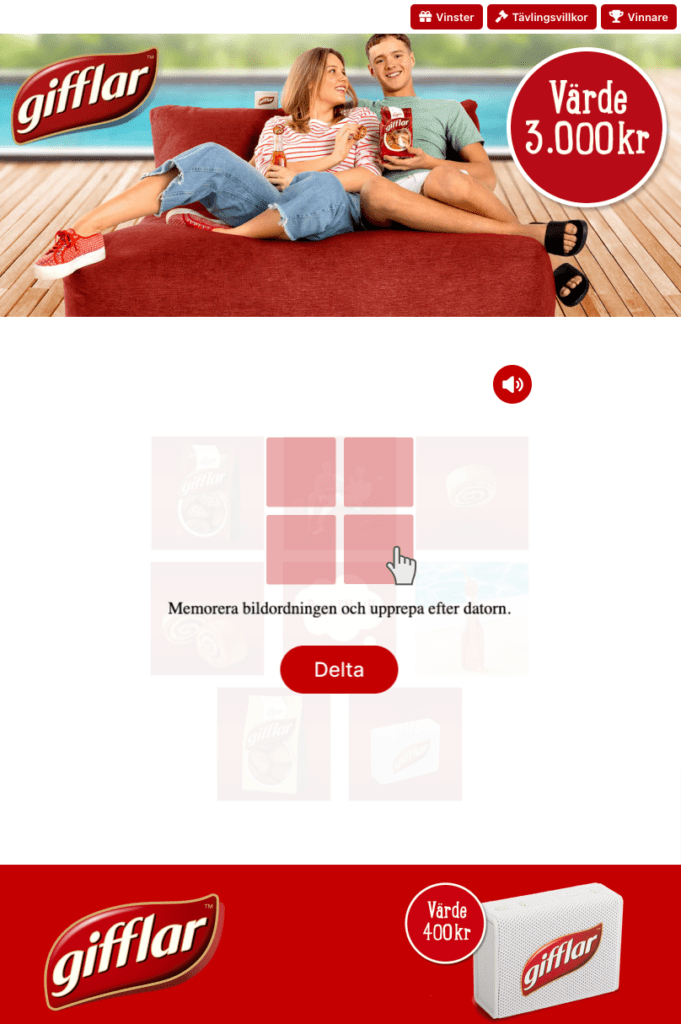
- The predefined objective is to win a series of great prizes (speakers, blow-up chairs, …).
- The limits and rules are set out in the general conditions.
- The player has to accept these general conditions.
- If they don’t, then they don’t take part in the prize draw at the end of the game.
So as you can see, all 4 rules are present, making this the perfect gamified experience! 👀
Interested in our ‘Repeat it!’ format? It’s one of our advanced formats, and is available as an add-on to your Qualifio licence.
Contact us for more information!
What are the origins of gamification?
Are you ready for a quick history lesson? Thinking caps on, here we go!
From a technological point of view, gamification is a relatively young subject of study. Researchers in HMI (human-machine interaction) have been showing an increasing interest in it since the 2000s. The term gamification has therefore become increasingly familiar to the wider public since the second half of the 2010s. How come? This is due to the sharp uptake and proliferation of cheaper technology, the rapid evolution of digital marketing, the need to collect personal data from consumers, the digital transformation of society, etc.

Playing games is in human nature
Playing games is a common activity in the everyday life of all animals and humans. And games have always existed as an integral part of human society. For many people, games provide an escape from the real world.
So could games change the way we think and act in everyday life? Jane McGonigal, best-selling author and gamification guru, certainly thinks so, and has written a whole book about how games have the potential to change the world and how they can make us better human beings.
Key factors to be considered
Let’s take a look at the factors that will allow brands to create an effective gamified campaign to stand out from the crowd. What do they need to put in place to get their audience to participate in their games and loyalty programs?
For whom?
The most important thing when considering applying gamification to a marketing campaign, is to remember who it is designed for. Who is the targeted audience?
For brands, the answer is straightforward, their community of consumers. So, they should be placed at the centre of the gamification mechanics, so that it feels like the campaign has been made for them.
How can you encourage a large number of consumers to take part in your gamified campaign? Motivate them!
Motivation is the willingness to set oneself in motion. But how? By providing them with a game that is desirable and feasible. Make sure that the game is easy and attractive, with desirable prizes up for grabs. This will increase motivation to participate – but be careful to not have too much risk in the game or that it takes up too much energy, as these 2 factors will decrease motivation.
Mastery
Mastery is each individual’s progression and acquisition of skills to pursue an identified and specific goal when playing a game. In general, mastery is often a good motivator because the player has to overcome obstacles, to move from level to level to reach a concrete goal. That creates a sense of achievement for players as they progress, and encourages them to continue.
Real-time feedback is essential for improving players’ mastery. How? Feedback stimulates us and pushes us to go further and improve ourselves. This is because our brain releases dopamine when something feels good. And, of course, we are biologically driven to repeat what feels good.
Our behaviour constantly evolves according to our experiences with positive and negative reinforcement of our actions.
And this is where Qualifio’s Loyalty module comes into play.
Twinned with the interactive formats from our Qualifio Engage module, Qualifio Loyalty enables brands to reward their audience for all the interactions they have with the brand, thanks to creative and fully-customisable loyalty programs. Clever, right!? These programs aim to reward customers for their interactions to develop a real sense of community. Thanks to loyalty programs, you can improve the mastery of your users with real-time feedback!
Here is the example of La Voz de España, a fictional media that offers a loyalty program for its readers! Why? To boost its revenue through reader engagement and loyalty! La Voz de España is a Spanish news website and newspaper based in Madrid. To achieve its goals, the media company has set up a personalised loyalty program, La Voz Community, which rewards all reader interactions with exclusive digital experiences, unique discounts and gifts!
The program has been divided into four parts:
1️⃣ The news corner with different quizzes and games that members can participate in to earn points.
2️⃣ The advertisers’ corner features a different partner each week with a dedicated game and a unique gift for members to win.
3️⃣ The question corner where members can collect zero-party data by asking them a different question about themselves each day in exchange for points.
4️⃣ The reader’s corner shows members other ways to interact with La Voz de España to earn more points.
For a more in-depth look at this program, see our blog post.
👉 Or join the “La Voz Community” and test the program yourself!
Flow
The state of flow is defined when someone is in a state of deep immersion in an activity, accompanied by a sense of engagement and accomplishment. To reach this state of fluidity, you need to have a very good narrative.
Narrative is the element that provides context and understanding for your gamified content. It not only immerses players in your game, it also connects your story to your brand and helps your audience to understand your brand’s personality.
Players want to experience something challenging which allows them to learn more about the company. Therefore, narrative creates a framework for the unique experience in which you can immerse your audience.
Take the example of this escape game format where participants have to answer questions correctly to move on to the next one and help Catherine get to work on time. For this interactive Mother’s day campaign, we created a story around the morning routine of a typical mum. And as we all know, mornings can be tricky 🤯 So in this game, participants must solve riddles to help Catherine to get to work on time!
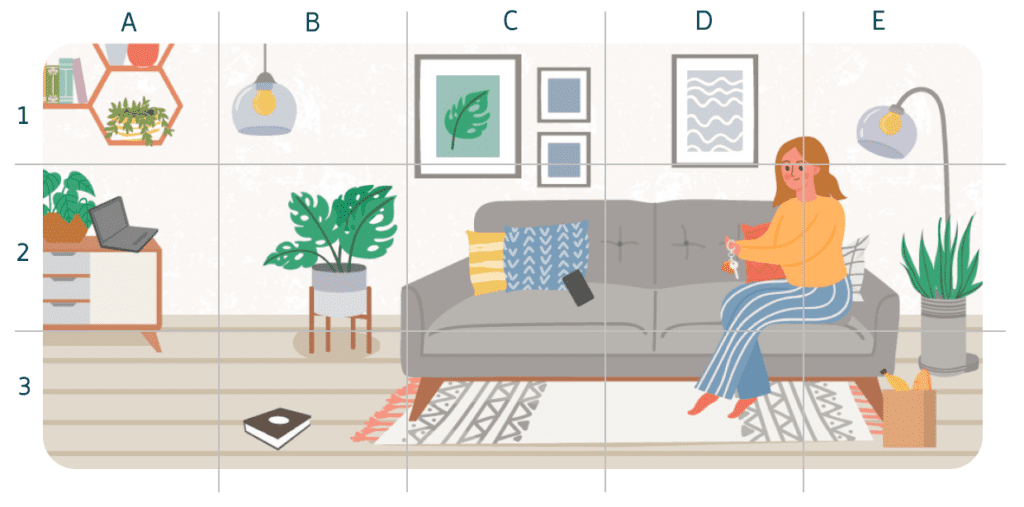
Other important gamification elements
✍️ Autonomy: give your players the freedom of choice and ability, as this will help them to explore their creativity and see how far they can go in the game. A good way of doing this is to create a customisable campaign where players can choose their names, create avatars, etc.
🪞 Esteem is how players perceive themselves, how players are and want to be perceived by others. Self-perception is directly related to the goal to be achieved and the mastery of the game.
👩👩👦👦 The feeling of belonging is a human need because we need to interact and be in contact with others. Humans seek to establish relationships or to be part of a group to prove their existence.
Now that everything is clear and you know what gamification is. Let’s look at how to apply it to marketing and why it’s worth using in your strategy!
Unilever’s brand Lipton had a precise idea in mind of the kind of game they wanted to create for their audience and they put everything in place to launch a unique campaign: Lipton’s personalised claw machine.
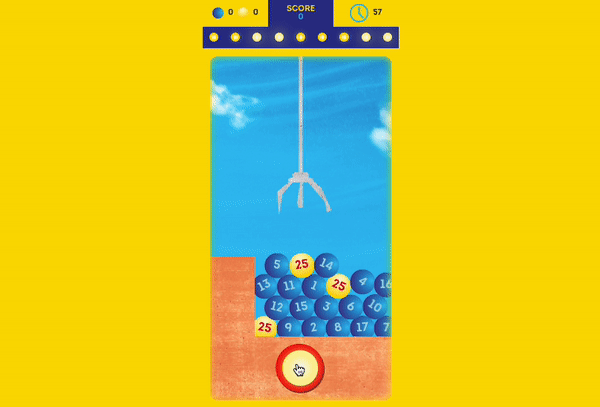
The Qualifio team worked on integrating the third-party game into the Qualifio campaign framework respecting Unilever’s visual identity.
Why is it interesting to use Qualifio in this case? Because Qualifio made it easy for Unilever to:
✅ Integrate a third-party game that is not part of Qualifio’s catalogue
✅ Implement winning rules
✅ Collect first-party data in a GDPR compliant way
✅ Maintain full control over their data
Gamification applied to marketing
In recent years, gamification has logically caught the attention of digital marketers looking to attract a wider audience and to promote their products in an innovative way. In their book, “Press Start: Using gamification to power-up your marketing”, Daniel Griffin and Albert van der Meer state that:
“Marketing gamification is the thoughtful application of relevant game elements to solve real-life customer problems that are connected to your organisation”
Gamification can be used in marketing in many ways: creating loyalty programs, offering rewards, creating games that promote your products, collecting first-party and zero-party data etc. 👀
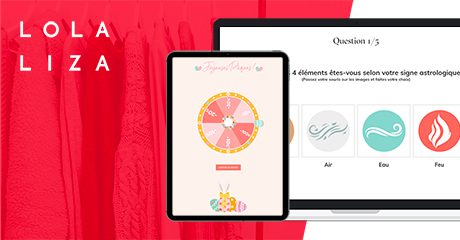
Want a concrete example? Half of the campaigns launched by LolaLiza are to promote and celebrate a new collection or a new product, the other half are for seasonal events. One of their most successful and appreciated marketing campaigns is the “What’s your colour?” personality test created for the launch of a particularly colourful collection.
Want to know more about it? Read our success story.
Interactive marketing campaigns
At the heart of marketing gamification, you’ll find interactive game mechanisms. Interactive marketing has been used for over a decade and requires the audience to engage, interact or take part in your content to get the most out of the entire brand experience.
Why is this so important? It improves brand awareness, drives audience engagement, builds audience loyalty and converts prospects into customers.
Qualifio Engage
How can Qualifio help you? We offer our clients the possibility to engage their audience on all their digital channels via more than 50 interactive formats (quizzes, contests, animated games etc.).
Want to discover other inspiring campaigns created by our users?
Take a look at our catalogue of all-time favourite campaigns!
An example is worth a thousand words 🔽
The global cosmetics brand L’Oréal aims to provide their audience with unique experiences thanks to interactive content. A good example is the catcher game they used for their brand Lancôme to celebrate the launch of a new perfume. Participants had to catch as many perfume bottles as possible in less than 25 seconds. You can read more about how the brand uses gamification to reach their data collection goals here.
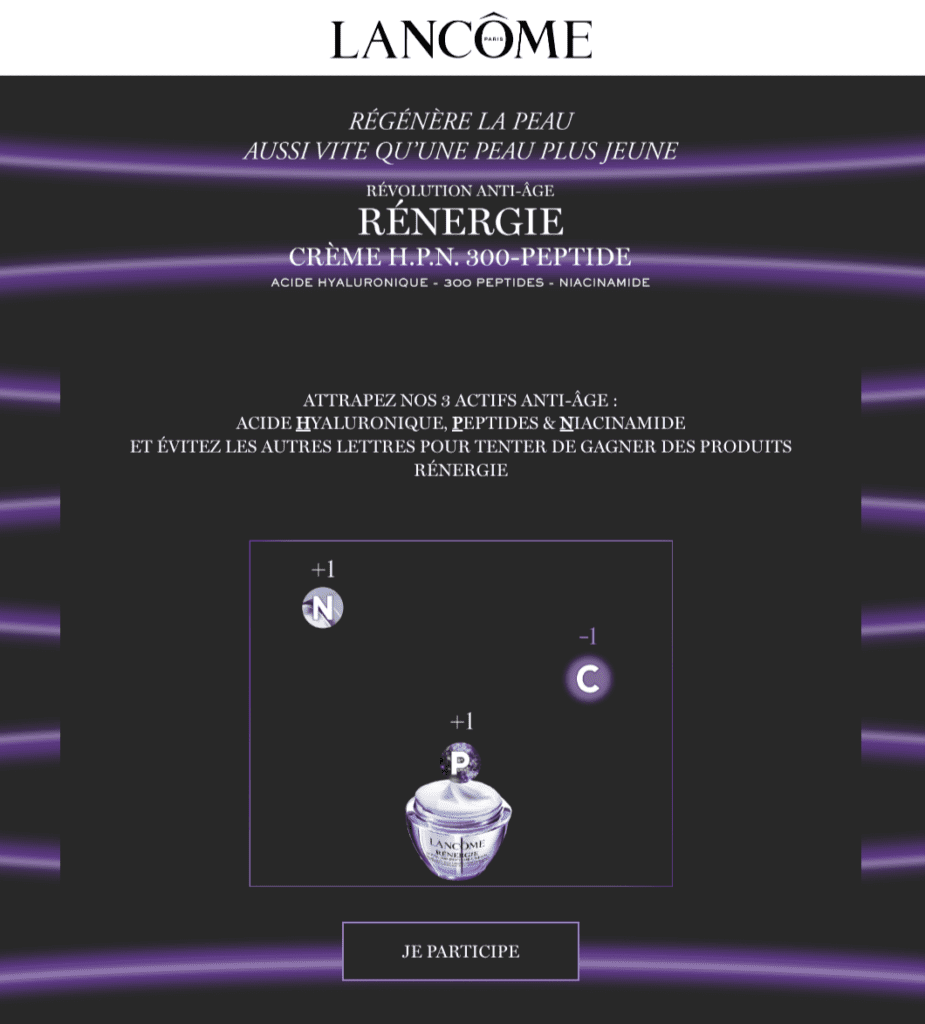
Why is gamification useful in marketing?
What are the advantages of using gamification in your marketing strategy? Using gamification mechanisms in your marketing campaigns creates more engaging and interactive customer experiences because you’re providing them with a fun format that they can interact with!
✨ Gamification doesn’t only benefit customers, it can benefit brands too.
So, it’s worth using it as a strategy to optimise the quality of the data you’re collecting, to improve customer engagement and loyalty, and to promote your brand. Integrate gamification into your marketing strategy so that it becomes an integral part of the personality of your brand.
Gamification to engage customers in a meaningful way
The goal of marketing is to optimise the user experience to make them return to your brand. But how? To do this, you’ll need to understand what motivates people to engage with and to stay engaged with a brand.
Gamification is a great way to encourage user engagement and enjoyment in non-game environments. Don’t hesitate to share tutorials or explanations so they can fully interact and immerse themselves in the game.
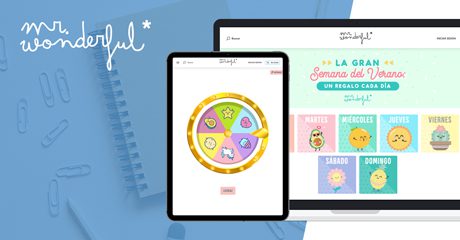
Still not convinced? Here is an example of an exceptional traffic boom that will quickly change your mind! Mr Wonderful is a brand that promotes positivity and good vibes across Europe with their colourful and fun products.
Social media (Instagram, Facebook, Twitter, Pinterest and TikTok) represents their main way of connecting with their community of two million people. To get closer to this community and build meaningful relationships, the brand decided to start integrating interactive content and games into their digital marketing plan. This strategic move has enabled the company to not only engage their followers but also to increase their website traffic and grow their database by collecting first-party data. As explained by Oriol Ristol, Head of Digital Marketing @ Mr. Wonderful:

“We immediately see the impact on our traffic when we launch an action with Qualifio, reaching up to 50% increase. And we see the same trend with our newsletter. Our email click-through rate, including Qualifio campaigns, is around 20%, compared to the usual 4%.”
You can find more information about this success story here.
Gamification to help collect valuable first- and zero-party data
Gamification can also help you to collect valuable data from your audience 🍪
How? By tracking customer behaviour as part of the gamified experience, you can gain insights into their preferences, habits and buying behaviours. So it’s a great way to collect first- and zero-party data! Need a quick reminder of what these types of data are? It’s right here 🔽
Zero-party data is data that a customer intentionally and proactively shares with a company. Why is it so important? It has 4 significant benefits:
1️⃣ The data collected is qualitative and accurate.
2️⃣ The data shared by the customer is relevant.
3️⃣ Zero-party data is very cost-effective.
4️⃣ The source and method of data collection are RGPD compliant.
First-party data is collected directly by companies from their audiences, customers and prospects. How is it collected? Via a form with an opt-in, for example! There are two types: declarative data and behavioural data. First-party data is helpful because it has been collected directly from the users that marketers want to reach!
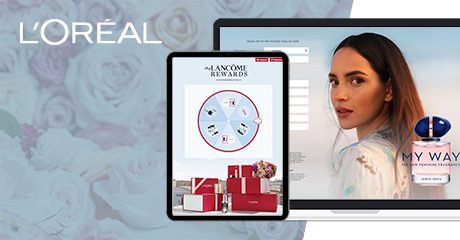
A global data collection strategy is essential for L’Oréal EMEA, as explained by Pasquale Egione, Consumer Engagement Program Manager:

“We needed to make sure all our brands were collecting data in the same way. So we decided to go for a global solution, integrated with our CRM and managed by our central CRM team, that all our brands could use to launch their data collection campaigns. Qualifio seemed to be the ideal tool to achieve this, approved on a security and a legal point of view by L’Oréal.”
That’s why the cosmetics brand launched a European data capture program directly integrated with their CRM. In terms of percentages, data collection is the main reason why L’Oréal uses Qualifio Engage. Discover all the details in the success story ✨
Gamification to promote products and services
Encourage consumers and prospects to buy and talk about your products and services by improving their customer experience. Gamified experiences allow you to effectively transfer your ideas and personality to your users. They understand who you are and what you do, so they’ll find it easier to relate. And guess what? It will also increase your visibility through word-of-mouth!
A great example of a brand launching a gamified campaign to promote a product? Look no further than Dutch brewery Swinkels. For their 8.6 brand, they launched an “urban art” game to promote their limited edition beers, created in collaboration with street artists.
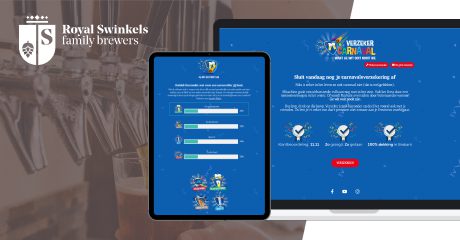
They put QR codes on the cans and challenged consumers to go online to play a game. Once connected, consumers had to find the limited edition beer hidden in the image as quickly as possible. The prize for the winner? A unique piece of art created by street artists. The campaign was launched in France, The Netherlands and La Reunion and had a 59% completion rate.
Read more about this arty use of gamification here.
A quick recap?
Gamification is still a relatively young subject but don’t be afraid to use it in your marketing strategy. It will allow you to stand out from your competitors! You can use it in many different ways: create games, offer loyalty programs, promote your products etc.
And you’ve guessed it, Qualifio can help! To launch your gamification marketing:
🤩 Use our Qualifio Engage module to create fun and interactive marketing campaigns to engage and collect precious first- and zero-party data from your audience.
🎁 Use our Qualifio Loyalty module to create outstanding loyalty programs to reward your players for all the interactions they have with your brand!
✅ And most importantly? Qualifio helps you to collect valuable customer data along the way.
A last example before you go? Check out one of our newest advanced formats: the obstacle run. The goal of this game is to run as far as you can by successfully navigating all of the obstacles. With our new format, you’ll be able to:
✅ Fully customise this gamified format
✅ Add it on your website or app
✅ Attract participants and keep them engaged
✅ Collect first- and zero-party data in a fun and non-intrusive way
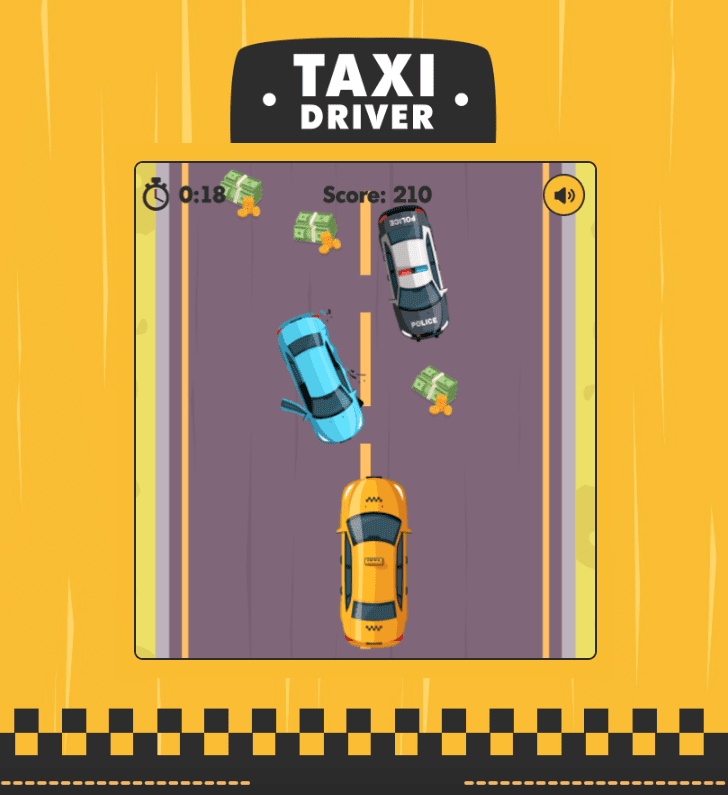
If you don’t want this to be « Game over » in your pursuit of gamification perfection for your marketing strategy! Contact us for more information, we will be glad to help you!
